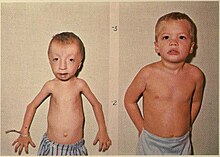| Seckel syndrome | |
|---|---|
| Other names | Harper's syndrome |
 | |
| Boy with Seckel syndrome (left) | |
| Specialty | Medical genetics |
| Causes | defects of genes on chromosome 3 and 18. |
Seckel syndrome, or microcephalic primordial dwarfism (also known as bird-headed dwarfism, Harper's syndrome, Virchow–Seckel dwarfism and bird-headed dwarf of Seckel) is an extremely rare congenital nanosomic disorder. Inheritance is autosomal recessive. It is characterized by intrauterine growth restriction and postnatal dwarfism with a small head, narrow bird-like face with a beak-like nose, large eyes with down-slanting palpebral fissures, receding mandible and intellectual disability.
A mouse model has been developed. This mouse model is characterized by a severe deficiency of ATR protein. These mice have high levels of replicative stress and DNA damage. Adult Seckel mice display accelerated aging. These findings are consistent with the DNA damage theory of aging.
Symptoms and signs
Symptoms include:
- intellectual disability (more than half of the patients have an IQ below 50)
- microcephaly
- sometimes pancytopenia (low blood counts)
- cryptorchidism in males
- low birth weight
- dislocations of pelvis and elbow
- unusually large eyes
- blindness or visual impairment
- large, low-set ears
- small chin due to receded lower jaw
Genetics
It is believed to be caused by defects of genes on chromosome 3 and 18. One form of Seckel syndrome can be caused by mutation in the gene encoding the ataxia telangiectasia and Rad3-related protein (ATR) which maps to chromosome 3q22.1–q24. This gene is central in the cell's DNA damage response and repair mechanism.
Types include:
| Type | OMIM | Gene | Locus |
|---|---|---|---|
| SCKL1 | 210600 | ATR | 3q23 |
| SCKL2 | 606744 | RBBP8 | 18q11 |
| SCKL4 | 613676 | CENPJ | 13q12 |
| SCKL5 | 613823 | CEP152 | 15q21.1 |
| SCKL6 | 614728 | CEP63 | 3q22.2 |
| SCKL7 | 614851 | NIN | 14q22.1 |
| SCKL8 | 615807 | DNA2 | 10q21.3 |
| SCKL9 | 616777 | TRAIP | 3p21.31 |
| SCKL10 | 617253 | NSMCE2 | 8q24.13 |
| SCKL11 | 620767 | CEP295 | 11q21 |
Diagnosis
There are 4 criteria for diagnosis:
- Congenital Dwarfism and postnatal growth retardation
- Microcephaly, large eyes, beak-like nose, narrow face, retrognathism, malocclusion
- Mental handicap
- Agenesis of the corpus callosum, cerebral cysts
Other abnormalities can be a supportive criteria, such as: anemia, pancytopenia, cleft lip/palate scoliosis or kyphoscoliosis.
Genetic testing can confirm diagnosis.
Treatment
There is no cure for Seckel syndrome. Symptomatic treatment is available.
History
The syndrome was named after German–American physician Helmut Paul George Seckel (1900–1960). The synonym Harper's syndrome was named after pediatrician Rita G. Harper.
See also
References
- Harsha Vardhan BG, Muthu MS, Saraswathi K, Koteeswaran D (2007). "Bird-headed dwarf of Seckel". J Indian Soc Pedod Prev Dent. 25 Suppl: S8–9. PMID 17921644.
- James Wynbrandt; Mark D. Ludman (February 2008). The encyclopedia of genetic disorders and birth defects. Infobase Publishing. pp. 344–. ISBN 978-0-8160-6396-3. Retrieved 7 January 2011.
- Jung M, Rai A, Wang L, Puttmann K, Kukreja K, Koh CJ (2018). "Nephrolithiasis in a 17-Year-Old Male With Seckel Syndrome and Horseshoe Kidneys: Case Report and Review of the Literature". Urology. 120: 241–243. doi:10.1016/j.urology.2018.05.023. PMID 29894776. S2CID 48353132.
- ^ Murga M, Bunting S, Montaña MF, et al. (August 2009). "A mouse model of ATR-Seckel shows embryonic replicative stress and accelerated aging". Nat. Genet. 41 (8): 891–8. doi:10.1038/ng.420. PMC 2902278. PMID 19620979.
- ^ "Seckel Syndrome - Symptoms, Causes, Treatment | NORD". rarediseases.org. Retrieved 2025-01-10.
- "Entry - #210600 - SECKEL SYNDROME 1; SCKL1 - OMIM". omim.org. Retrieved 2025-01-10.
- Bissonnette, Bruno; Luginbuehl, Igor; Engelhardt, Thomas (2019), "Seckel Syndrome", Syndromes: Rapid Recognition and Perioperative Implications (2 ed.), New York, NY: McGraw-Hill Education, retrieved 2025-01-10
- Bissonnette, Bruno; Luginbuehl, Igor; Engelhardt, Thomas (2019), "Seckel Syndrome", Syndromes: Rapid Recognition and Perioperative Implications (2 ed.), New York, NY: McGraw-Hill Education, retrieved 2025-01-10
- "Seckel Syndrome - Symptoms, Causes, Treatment | NORD". rarediseases.org. Retrieved 2025-01-10.
- Kelana, Andreas Dhymas Dhyna Martha; Windiani, Gusti Ayu Trisna; Arimbawa, Made; Adnyana, Gusti Agung Ngurah Sugitha; Yuda, Made Darma; Murti, Ni Luh Sukma Pratiwi; Soetjiningsih, Soetjiningsih (2023-01-04). "Case of Seckel Syndrome in a 9-month-old Girl". Open Access Macedonian Journal of Medical Sciences. 11 (C): 6–10. doi:10.3889/oamjms.2023.10988. ISSN 1857-9655.
- Seckel, H. P. G. Bird-headed Dwarfs: Studies in Developmental Anthropology Including Human Proportions. Springfield, Ill.: Charles C Thomas (pub.) 1960.
- "Seckel's syndrome".
- Harper RG, Orti E, Baker RK (May 1967). "Bird-beaded dwarfs (Seckel's syndrome). A familial pattern of developmental, dental, skeletal, genital, and central nervous system anomalies". J. Pediatr. 70 (5): 799–804. doi:10.1016/S0022-3476(67)80334-2. PMID 6022184.
External links
| Classification | D |
|---|---|
| External resources |
| Congenital abnormality syndromes | |
|---|---|
| Craniofacial | |
| Short stature | |
| Limbs | |
| Overgrowth syndromes | |
| Laurence–Moon–Bardet–Biedl | |
| Combined/other, known locus | |
| Deficiencies of intracellular signaling peptides and proteins | |||||||
|---|---|---|---|---|---|---|---|
| GTP-binding protein regulators |
| ||||||
| G protein |
| ||||||
| MAP kinase | |||||||
| Other kinase/phosphatase |
| ||||||
| Signal transducing adaptor proteins | |||||||
| Other | |||||||
| See also intracellular signaling peptides and proteins | |||||||
| Nucleus diseases | |
|---|---|
| Telomere | |
| Nucleolus | |
| Centromere | |
| Other | |
| see also nucleus | |